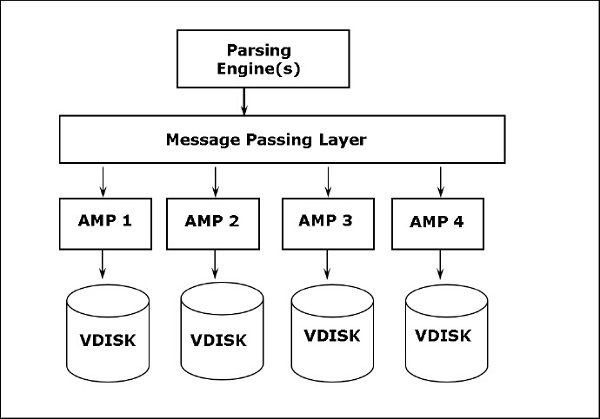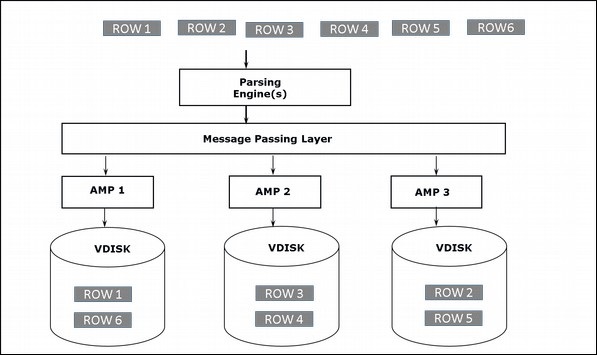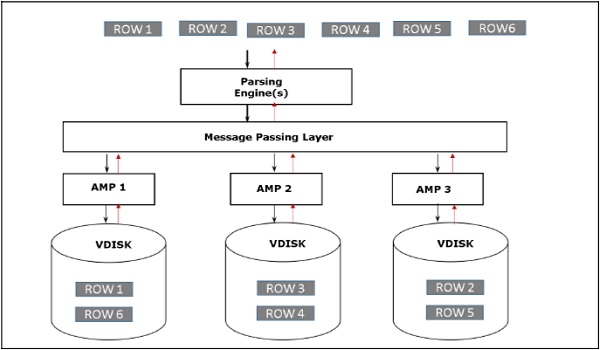
- Teradata - Introduction
- Teradata - Installation
- Teradata - Architecture
- Teradata - Relational Concepts
- Teradata - Data Types
- Teradata - Tables
- Teradata - Data Manipulation
- Teradata - SELECT Statement
- Logical & Conditional Operators
- Teradata - SET Operators
- Teradata - String Manipulation
- Teradata - Date/Time Functions
- Teradata - Built-in Functions
- Teradata - Aggregate Functions
- Teradata - CASE & COALESCE
- Teradata - Primary Index
- Teradata - Joins
- Teradata - SubQueries
- Teradata Advanced
- Teradata - Table Types
- Teradata - Space Concepts
- Teradata - Secondary Index
- Teradata - Statistics
- Teradata - Compression
- Teradata - Explain
- Teradata - Hashing Algorithm
- Teradata - Join Index
- Teradata - Views
- Teradata - Macros
- Teradata - Stored Procedure
- Teradata - JOIN Strategies
- Teradata - Partitioned Primary Index
- Teradata - OLAP Functions
- Teradata - Data Protection
- Teradata - User Management
- Teradata - Performance Tuning
- Teradata - FastLoad
- Teradata - MultiLoad
- Teradata - FastExport
- Teradata - BTEQ
- Teradata Useful Resources
- Teradata - Questions & Answers
- Teradata - Quick Guide
- Teradata - Useful Resources
- Teradata - Discussion
Teradata - Architecture
Teradata architecture is based on Massively Parallel Processing (MPP) architecture. The major components of Teradata are Parsing Engine, BYNET and Access Module Processors (AMPs). The following diagram shows the high level architecture of a Teradata Node.

Components of Teradata
The key components of Teradata are as follows −
Node − It is the basic unit in Teradata System. Each individual server in a Teradata system is referred as a Node. A node consists of its own operating system, CPU, memory, own copy of Teradata RDBMS software and disk space. A cabinet consists of one or more Nodes.
-
Parsing Engine − Parsing Engine is responsible for receiving queries from the client and preparing an efficient execution plan. The responsibilities of parsing engine are −
Receive the SQL query from the client
Parse the SQL query check for syntax errors
Check if the user has required privilege against the objects used in the SQL query
Check if the objects used in the SQL actually exists
Prepare the execution plan to execute the SQL query and pass it to BYNET
Receives the results from the AMPs and send to the client
Message Passing Layer − Message Passing Layer called as BYNET, is the networking layer in Teradata system. It allows the communication between PE and AMP and also between the nodes. It receives the execution plan from Parsing Engine and sends to AMP. Similarly, it receives the results from the AMPs and sends to Parsing Engine.
Access Module Processor (AMP) − AMPs, called as Virtual Processors (vprocs) are the one that actually stores and retrieves the data. AMPs receive the data and execution plan from Parsing Engine, performs any data type conversion, aggregation, filter, sorting and stores the data in the disks associated with them. Records from the tables are evenly distributed among the AMPs in the system. Each AMP is associated with a set of disks on which data is stored. Only that AMP can read/write data from the disks.
Storage Architecture
When the client runs queries to insert records, Parsing engine sends the records to BYNET. BYNET retrieves the records and sends the row to the target AMP. AMP stores these records on its disks. Following diagram shows the storage architecture of Teradata.

Retrieval Architecture
When the client runs queries to retrieve records, the Parsing engine sends a request to BYNET. BYNET sends the retrieval request to appropriate AMPs. Then AMPs search their disks in parallel and identify the required records and sends to BYNET. BYNET then sends the records to Parsing Engine which in turn will send to the client. Following is the retrieval architecture of Teradata.
